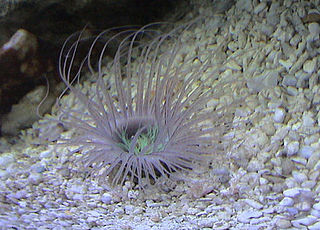
In taxonomy, binomial nomenclature, also called binominal nomenclature or binary nomenclature, is a formal system of naming species of living things by giving each a name composed of two parts, both of which use Latin grammatical forms, although they can be based on words from other languages. Such a name is called a binomial name, a binomen, binominal name or a scientific name; more informally it is also called a Latin name.

Honeyguides are near passerine birds in the order Piciformes. They are also known as indicator birds, or honey birds, although the latter term is also used more narrowly to refer to species of the genus Prodotiscus. They have an Old World tropical distribution, with the greatest number of species in Africa and two in Asia. These birds are best known for their interaction with humans. Honeyguides are noted and named for one or two species that will deliberately lead humans directly to bee colonies, so that they can feast on the grubs and beeswax that are left behind.

The Cyclopteridae are a family of marine fishes, commonly known as lumpsuckers or lumpfish, in the order Scorpaeniformes. They are found in the cold waters of the Arctic, North Atlantic, and North Pacific oceans. The greatest number of species are found in the North Pacific. The family name Cyclopteridae derives from the Greek words κύκλος (kyklos), meaning "circle", and πτέρυξ (pteryx), meaning "wing" or "fin", in reference to the circle-shaped pectoral fins of most of the fish in this family.

The Cephalocarida are a class in the subphylum Crustacea comprising only 12 benthic species. They were discovered in 1955 by Howard L. Sanders, and are commonly referred to as horseshoe shrimps. They have been grouped together with the Remipedia in the Xenocarida. Although a second family, Lightiellidae, is sometimes used, all cephalocaridans are generally considered to belong in just one family: Hutchinsoniellidae. Though no fossil record of cephalocaridans has been found, most specialists believe them to be primitive among crustaceans.

Tube-dwelling anemones or ceriantharians look very similar to sea anemones but belong to an entirely different subclass of anthozoans. They are solitary, living buried in soft sediments. Tube anemones live inside and can withdraw into tubes, which are composed of a fibrous material made from secreted mucus and threads of nematocyst-like organelles known as ptychocysts. Within the tubes of these ceriantharians, more than one polyp is present, which is an exceptional trait because species that create tube systems usually contain only one polyp per tube. Ceriantharians were formerly classified in the taxon Ceriantipatharia along with the black corals but have since been moved to their own subclass, Ceriantharia.

Araneus is a genus of common orb-weaving spiders. It includes about 650 species, among which are the European garden spider and the barn spider. The genus was erected by Carl Alexander Clerck in 1757.

Phalangiotarbi is an extinct arachnid order first recorded from the Early Devonian of Germany and most widespread in the Upper Carboniferous coal measures of Europe and North America. The last species are known from the early Permian Rotliegend of Germany.

Sternotherus is a genus of aquatic turtles, known commonly as musk turtles, in the family Kinosternidae. The genus is endemic to North America and is closely related to Kinosternon. The most common species of Sternotherus in most of North America is Sternotherus odoratus, the common musk turtle or stinkpot; that entry has more information on the ecology of this group of turtles.
Triunia is a genus of medium to tall shrubs or small trees found as understorey plants in rainforests of eastern Australia. Members of the plant family Proteaceae, they are notable for their poisonous fleshy fruits or drupes. Only one species, T. youngiana, is commonly seen in cultivation.

Eupterotidae is a family of insects in the order Lepidoptera with more than 300 described species.

Lamiinae, commonly called flat-faced longhorns, are a subfamily of the longhorn beetle family (Cerambycidae). The subfamily includes over 750 genera, rivaled in diversity within the family only by the subfamily Cerambycinae.

The Palaeonisciformes are an extinct order of early ray-finned fishes (Actinopterygii) which began in the Late Silurian and ended in the Late Cretaceous. The name of the order is derived from the Greek words paleo (ancient) and ὀνίσκος, probably pertaining to the organization of the fishes' scales, similar to the exoskeletal plating of woodlice.

The minute tree-fungus beetles, family Ciidae, are a sizeable group of beetles which inhabit Polyporales bracket fungi or coarse woody debris. Most numerous in warmer regions, they are nonetheless widespread and a considerable number of species occur as far polewards as Scandinavia for example.

Odontaspis is a genus of sand shark with two extant species.
Scalenodon is an extinct genus of traversodontid cynodonts from the Middle Triassic of Africa and possibly Russia. The type species S. angustifrons was named in 1946 and several other species were named in the following years. Most of the species from Africa are now thought to belong to different genera than Scalenodon.
Cornelis Eliza Bertus Bremekamp was a Dutch botanist.
Catalepidia is a genus of a sole described species of medium-sized trees, constituting part of the plant family Proteaceae. The species Catalepidia heyana grows naturally only in a restricted mountain region (endemic) of the wet tropics rain forests of north-eastern Queensland, Australia. Common names include Hey's nut or Hey's nut oak.
John Ernest "Jack" Randall was an American ichthyologist and a leading authority on coral reef fishes. Randall described over 800 species and authored 11 books and over 900 scientific papers and popular articles. He spent most of his career working in Hawaii. He died in April 2020 at the age of 95.
Grevillea hislopii is a shrub of the genus Grevillea native to a small area in the Wheatbelt and Eastern Metropolitan regions of Western Australia. It was named in honour of Perth botanist Michael Clyde Hislop.
Rheomorpha is a monotypic genus of freshwater annelids belonging to the family Aeolosomatidae.












